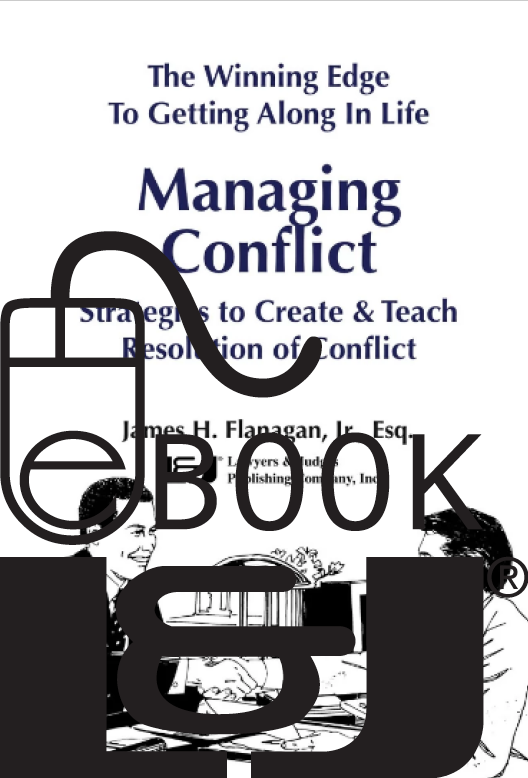
The Winning Edge to Getting Along in Life: Managing Conflict PDF eBook
- Author: James H. Flanagan, Jr., Esq.
- ISBN 10: 1-936360-47-0
- ISBN 13: 978-1-936360-47-5
- Copyright Date Ed: February 1, 2016
- Pages: 80
- PDF eBook
Differences of opinion and preference, as well as disagreements generally, are a normal part of life. There is a spectrum of the process of agreement to disagreement to conflict. Lawyers, politicians, business men, and people in general could be more successful in communicating if they applied the principles of conflict resolution. We must learn how to better prevent, manage, and resolve conflict.
“Jim Flanagan’s book on Conflict Management reflects his 44 years of experience as a trial lawyer and provides sage advice and hard-won wisdom. His methodology for dealing with conflict incorporates the teachings of the ancient philosophers together with modern thoughts to bring about a systematic approach to conflict. A must read for anyone dealing with people in any situation.”
—Gregory Zubacz, Ph.D., Director of the Center for
Peacemaking and Conflict Studies, Fresno Pacific University.
“In Managing Conflict Jim Flanagan gives us a very practical process for developing the crucial life skills of solving problems and persuading others. I agree with Jim that these skills are so life-critical that they should be taught to everyone at every age.”
—Vic Conant, President of Nightingale-Conant Corporation.
“This insightful book shows the best methods and strategies ever discovered to resolve conflicts and achieve lasting agreements.”
—Brian Tracy, author of Negotiation, and
Chair and CEO of Brian Tracy International.
“Preventing and resolving conflicts are life skills that should be taught at every level. Mr. Flanagan concisely captures and explains the elements of the art of negotiation, which are essential in the development of civil and respectful citizens.”
—Jim Yovino, Fresno County Superintendent of Schools.
“Jim Flanagan brings a deep perspective to issues of this sort. Highly educated and steeped in practical experience, he brings a different and important light to a serious issue.”
—Al Smith, retired prominent radio station manager,
former CEO of the Fresno Chamber of Commerce.
Table of Contents
Acknowledgements
Dedication
Part One — Introduction
Forward — Why the Title
Preface — Why the Book & What the Book is About
Why This Book is Different
(1) The Conflict Process as a Spectrum
(2) Agreement as a Natural Condition
(3) Conflict Can be Prevented
(4) Negotiation/Persuasion Should be Taught
Book Summary
Chapter 1 — The Conflict Spectrum™
Part Two — The Conflict Spectrum™ Process
Chapter 2 — Stay At Yes™ — Maintaining Agreement
Agreement as a Natural Condition
Dispute & Conflict
Negotiation
Chapter 3 — Conflict Prevention — Transactional Negotiation
Preparing to Negotiate
The Way, The Weather, & The Terrain
The Agreement & Performance Phase
Prevention of Conflict
Persuasion
Relationships
Chapter 4 — Conflict Resolution — Dispute Negotiation
Negotiation
Dispute Negotiation
(1) Defining the Problem
(2) Exploring Alternatives
(3) Beginning the Dialogue
Chapter 5 — Mediation — Facilitated Negotiation
Three Basic Steps (including script at end of chapter)
Three Forms of Mediation That Should be Avoided
Mediation Script
Chapter 6 — The Tool Box — Necessary Communication Skills
The Basic Elements of Communication—The What & How
Six Basic Elements
(1) Non-Verbal Body Language
(2) Verbal Spoken Language
(3) Non-Verbal Tonality of Voice
(4) Congruence & Blending of Language
(a) Congruence of Language
(b) Blending of Language
(5) Active Listening
Stop, Look, & Listen
Pay Heed
A Formula for Active Listening
(6) Blocks to Communication
Chapter 7 — Persuasion — Selling Ideas
A. Truth & Trust — The Basics
B. Persuasion is Salesmanship
C. Importance of Focusing on Interests
D. How Winners Persuade
E. Preparation
F. Attitude
G. Telephone Talk
H. Take Notes
Part Three — Teaching the Conflict Spectrum™ Process
Chapter 8 — Teaching Stay At Yes™ and the Conflict Spectrum™
The Why
The How
Part Four – Conclusion
Chapter 9 — Putting It All Together
Trust & Truth
Preparation & Negotiation
Basic Elements of Communication
Teaching
Epilogue: My Conflict Epiphany—How to Avoid Conflict
Endnotes
References
About the Author
Endorsements
Index
